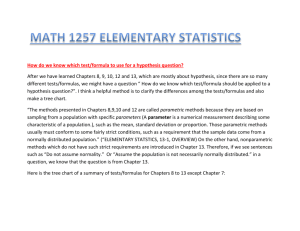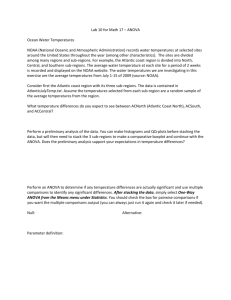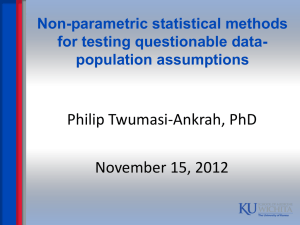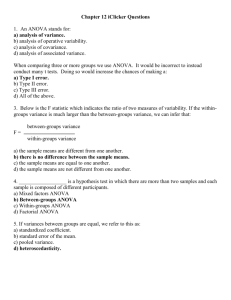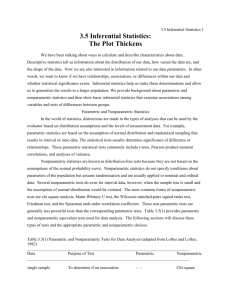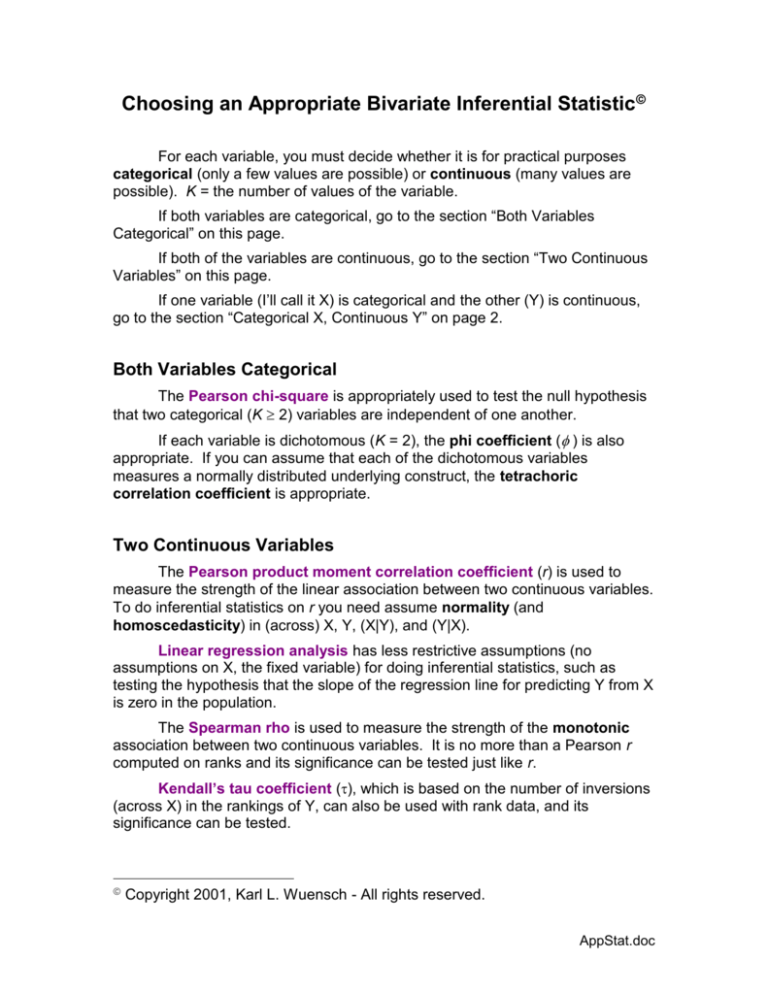
Choosing an Appropriate Bivariate Inferential Statistic
For each variable, you must decide whether it is for practical purposes
categorical (only a few values are possible) or continuous (many values are
possible). K = the number of values of the variable.
If both variables are categorical, go to the section “Both Variables
Categorical” on this page.
If both of the variables are continuous, go to the section “Two Continuous
Variables” on this page.
If one variable (I’ll call it X) is categorical and the other (Y) is continuous,
go to the section “Categorical X, Continuous Y” on page 2.
Both Variables Categorical
The Pearson chi-square is appropriately used to test the null hypothesis
that two categorical (K 2) variables are independent of one another.
If each variable is dichotomous (K = 2), the phi coefficient ( ) is also
appropriate. If you can assume that each of the dichotomous variables
measures a normally distributed underlying construct, the tetrachoric
correlation coefficient is appropriate.
Two Continuous Variables
The Pearson product moment correlation coefficient (r) is used to
measure the strength of the linear association between two continuous variables.
To do inferential statistics on r you need assume normality (and
homoscedasticity) in (across) X, Y, (X|Y), and (Y|X).
Linear regression analysis has less restrictive assumptions (no
assumptions on X, the fixed variable) for doing inferential statistics, such as
testing the hypothesis that the slope of the regression line for predicting Y from X
is zero in the population.
The Spearman rho is used to measure the strength of the monotonic
association between two continuous variables. It is no more than a Pearson r
computed on ranks and its significance can be tested just like r.
Kendall’s tau coefficient (), which is based on the number of inversions
(across X) in the rankings of Y, can also be used with rank data, and its
significance can be tested.
Copyright 2001, Karl L. Wuensch - All rights reserved.
AppStat.doc
Categorical X, Continuous Y
You need to decide whether your design is independent samples (no
correlation expected between Y at any one level of X and Y at any other level of
X, also called between subjects or Completely Randomized Design—subjects
randomly sampled from the population and randomly assigned to treatments) or
correlated samples. Correlated samples designs include the following: Withinsubjects (also known as “repeated measures”) and randomized blocks, (also
know as matched pairs or split-plot). In within-subjects designs each subject is
tested (measured on Y) at each level of X. That is, the (third, hidden) variable
Subjects is crossed with rather than nested within X.
I am assuming that you are interested in determining the “effect” of X
upon the location (central tendency - mean, median) of Y rather than
dispersion (variability) in Y or shape of distribution of Y. If it is variance in Y
that interests you, use an FMAX Test (see Wuensch for special tables if K > 2 or
for more powerful procedures), Levene’s test, or Obrien’s test, all for
independent samples. For correlated samples, see Howell's discussion of the
use of t derived by Pitman (Biometrika, 1939). If you wish to determine whether
X has any effect on Y (location, dispersion, or shape), use one of the
nonparametrics.
Independent Samples
For K 2, the independent samples parametric one-way analysis of
variance is the appropriate statistic if you can meet its assumptions, which are
normality in Y at each level of X and constant variance in Y across levels of X
(homogeneity of variance). You may need to transform or trim or Windsorize Y
to meet the assumptions. If you can meet the normality assumption but not the
homogeneity of variance assumption, you should adjust the degrees of freedom
according to Box or adjust df and F according to Welch.
For K 2, the Kruskal-Wallis nonparametric one-way analysis of
variance is appropriate, especially if you have not been able to meet the
normality assumption of the parametric ANOVA. To test the null hypothesis that
X is not associated with location of Y you must be able to assume that the
dispersion in Y is constant across levels of X and that the shape of the
distribution of Y is constant across levels of X.
For K = 2, the parametric ANOVA simplifies to the pooled variances
independent samples t test. The assumptions are the same as for the
parametric ANOVA. The computed t will be equal to the square root of the F that
would be obtained were you to do the ANOVA and the p will be the same as that
from the ANOVA. A point-biserial correlation coefficient is also appropriate
here. In fact, if you test the null hypothesis that the point-biserial = 0 in the
population, you obtain the exact same t and p you obtain by doing the pooled
variances independent samples t-test. If you can assume that dichotomous X
represents a normally distributed underlying construct, the biserial correlation
is appropriate. If you cannot assume homogeneity of variance, use a separate
2
variances independent samples t test, with the critical t from the BehrensFisher distribution (use Cochran & Cox’ approximation) or with df adjusted (the
Welch-Satterthwaite solution).
For K = 2, with nonnormal data, the Kruskal-Wallis could be done, but
more often the rank nonparametric statistic employed will be the nonparametric
Wilcoxon rank sum test (which is essentially identical to, a linear
transformation of, the Mann-Whitney U statistic). Its assumptions are identical
to those of the Kruskal-Wallis.
Correlated Samples
For K 2, the correlated samples parametric one-way analysis of
variance is appropriate if you can meet its assumptions. In addition to the
assumptions of the independent samples ANOVA, you must assume sphericity
which is essentially homogeneity of covariance—that is, the correlation
between Y at Xi and Y at Xj must be the same for all combinations of i and j.
This analysis is really a Factorial ANOVA with subjects being a second X, an X
which is crossed with (rather than nested within) the other X, and which is
random-effects rather than fixed-effects. If subjects and all other X’s were fixedeffects, you would have parameters instead of statistics, and no inferential
procedures would be necessary. There is a multivariate approach to the
analysis of data from correlated samples designs, and that approach makes no
sphericity assumption. There are also ways to correct (alter the df) the
univarariate analysis for violation of the sphericity assumption.
For K 2 with nonnormal data, the rank nonparametric statistic is the
Friedman ANOVA. Conducting this test is equivalent to testing the null
hypothesis that the value of Kendall’s coefficient of concordance is zero in the
population. The assumptions are the same as for the Kruskal-Wallis.
For K = 2, the parametric ANOVA could be done with normal data but the
Correlated samples t-test is easier. We assume that the difference-scores are
normally distributed. Again, t F .
For K = 2, a Friedman ANOVA could be done with nonnormal data, but
more often the nonparametric Wilcoxon’s signed-ranks test is employed. The
assumptions are the same as for the Kruskal-Wallis. Additionally, for the test to
make any sense, the difference-scores must be rankable (ordinal), a conditional
that is met if the data are interval. A binomial sign test could be applied, but it
lacks the power of the Wilcoxon.
3
ADDENDUM
Parametric Versus Nonparametric
The parametric procedures are usually a bit more powerful than the
nonparametrics if their assumptions are met. Thus, you should use a parametric
test if you can. The nonparametric test may well have more power than the
parametric test if the parametric test’s assumptions are violated, so, if you
cannot meet the assumptions of the parametric test, using the nonparametric
should both keep alpha where you set it and lower beta.
Categorical X with K > 2, Continuous Y
If your omnibus (overall) analysis is significant (and maybe even if it is not)
you will want to make more specific comparisons between pairs of means (or
medians). For nonparametric analysis, use one of the Wilcoxon tests. You may
want to use the Bonferroni inequality (or Sidak’s inequality) to adjust the per
comparison alpha downwards so that familywise alpha does not exceed some
reasonable (or, unreasonable, like .05) value. For parametric analysis there are
a variety of fairly well known procedures such as Tukey’s tests, REGWQ,
Newman-Keuls, Dunn-Bonferroni, Dunn-Sidak, Dunnett, etc. Fisher’s LSD
protected test may be employed when K = 3.
More Than One X and/or More Than One Y
Now this is multivariate statistics. The only one covered in detail in
PSYC 6430 is factorial ANOVA, were the X’s are categorical and the one Y is
continuous. There are many other possibilities, however, and these are covered
in PSYC 6431, as are complex factorial ANOVAs, including those with subjects
being crossed with other X’s or crossed with some and nested within others. We
do cover polynomial regression/trend analysis in PSYC 6430, which can be
viewed as a multiple regression analysis.
Copyright 2001, Karl L. Wuensch - All rights reserved.
4


